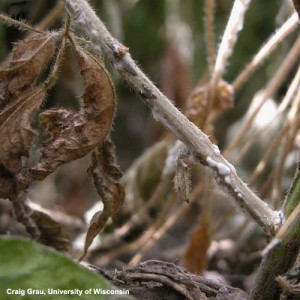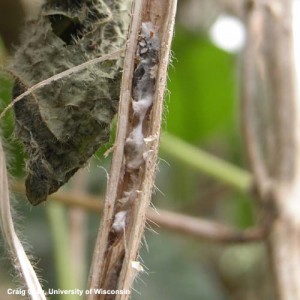White mold of soybean, also called Sclerotinia stem rot, was discovered in Central Illinois in 1948. Although white mold became a chronic problem in Michigan, Minnesota, and Wisconsin by the 1970’s, the remainder of the North Central states experienced no problems with the disease. Even in the Great Lakes states, outbreaks of white mold were generally localized and occurred where soybeans were grown in rotation with other susceptible crops.
Beginning in 1990, however, the occurrence of white mold started to become widespread in each of the Great Lakes states, and by 1992 was prevalent throughout the other North Central states. Because of its expanded geographic range and more frequent occurrence, white mold has progressed from a sporadic disease to an annual threat to soybean production throughout the upper North Central region.
Why is white mold increasing?
Reasons for the sudden increase of white mold in the region are not fully understood, but could be related to changes in cultural practices and/or changes in the genetic base of current soybean varieties or the white mold pathogen. Soybean producers are adapting management practices to maximize yield, and white mold is a disease of high yield potential soybeans. This situation is unfortunate because white mold penalizes the progressive soybean grower.
The growth and pathogenic activity of the white mold fungus are governed by the environment in the crop canopy, and is particularly favored by dense soybean canopies created by planting in narrow row widths, high seeding densities, early planting, high soil fertility and other factors that promote plant health.
Although not fully documented, there is some evidence that suggests the genetic base of current soybean varieties has changed resulting in greater susceptibility to the white mold pathogen compared to older varieties. Changes in herbicide usage and rate for corn, for example triazine herbicides, has been projected as another piece to the white mold puzzle.
The pathogen, Sclerotinia sclerotiorum
White mold is caused by the fungus Sclerotinia sclerotiorum. The disease cycle begins with the formation of apothecia on the soil surface. Later, white fluffy mycelium (the vegetative body of the fungus) is present, which is the source of the name white mold.
Each year, the occurrence of white mold is heavily dependent on weather conditions during soybean flowering and early pod development when apothecia and spores form. Rain, cool temperatures (less than 85 F), high relative humidity and moist soil favor the growth of the fungus if it is present. Read more about the disease cycle>
Hosts of Sclerotinia sclerotiorum
The trend to plant soybeans more frequently in specific fields is another factor contributing to the white mold problem. The more frequently a host crop is present, the more opportunity the white mold pathogen has to reproduce and reach population densities in soil that can result in outbreaks of white mold. The risk of white mold is even greater if other host crops are grown in rotation with soybean.
The white mold pathogen infects many broadleaf plants. Highly susceptible crops are soybean, dry beans, snap bean, lima bean, sunflowers, canola, carrots, and cabbage. Pea, potato, alfalfa, and read clover are hosts, but are examples of crops that are much less susceptible to the white mold pathogen. Examples of non-host crops are corn, small grains, and all forage grasses. Currently all forms of the pathogen are believed to be equally pathogenic to all hosts and varieties of soybean.
White mold in Wisconsin
White mold disease cycle
White mold risk assessment
White mold management





